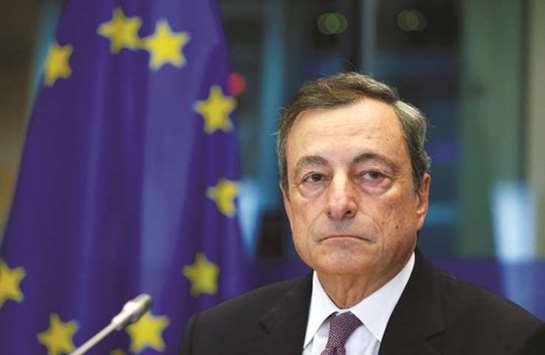The European Central Bank followed the Federal Reserve’s map when it began buying bonds, but it’s set to pursue a different route out of emergency stimulus.
Almost four years since the Fed began slowing its quantitative-easing programme, ECB president Mario Draghi was preparing to unveil later yesterday how his institution will pull back after purchasing more than €2tn ($2.4tn) of debt. The path it chooses is critical for the economy and for markets that have been bolstered by that support.
Unlike the Fed, the ECB will begin withdrawing even with inflation projected to remain below its target, and amid a looming shortage of eligible debt. That undershoot and the memory of past policy errors mean Draghi is likely to adopt tactics the Fed didn’t need – buying bonds until he can’t any longer and emphasising the punch of reinvesting money from debt that matures.
“It’s been very well telegraphed that whatever the ECB would do will be extraordinarily cautious,” said James Nixon, a former economist at the central bank, who now works for Oxford Economics in London. “Policymakers have to step away from the table without the whole house of cards falling down.”
Despite recovering the jobs and output lost in its double-dip recession over the past decade and business confidence in Germany at a record high, the 19-nation euro area is still struggling to lift consumer prices. Inflation was 1.5% in September and isn’t projected to reach the goal of just under 2% until at least late 2019.
Some blame the ECB’s late start.
“It has to do more QE and for longer in order to compensate for its past mistakes of keeping policy too tight,” said former policy maker Athanasios Orphanides, who headed Cyprus’s central bank from 2007 to 2012. “The ECB should not be tempted to follow the Fed in tightening policy without first providing sufficient accommodation to raise inflation.”
When the Fed’s third and final QE round ended with a gentle taper in October 2014, the ECB’s Governing Council was still wrangling over whether to plump for large-scale asset purchases. It finally agreed on a plan in early 2015, by which time the currency bloc was flirting with deflation.
The Frankfurt-based central bank – which also cut one of its key interest rates below zero and offered free long-term loans to banks – will see its balance sheet balloon to around €4.5tn by the end of the year, the equivalent of more than 40% of euro-area gross domestic product. The Fed’s balance sheet of $4.5tn is about a quarter of GDP. The volume of purchases is one reason why the ECB risks running out of debt to buy, at least under current rules.
With some policy makers judging the remaining capacity at just over €200bn after December, the Governing Council is considering a plan known as lower-for-longer. One option would be to cut the monthly pace by at least half from the current €60bn, extend the program to September, and pledge to do more if needed.
That contrasts with the Fed, which reduced buying from $85bn in $10bn steps over 10 months.
Bloomberg economists argue that the program is flexible enough to give the central bank room to expand purchases without running into shortages. Even then though, the biggest buyer, Germany’s Bundesbank, may need “a little creativity” with its strategy. That country has a budget surplus, reducing the government’s issuance of fresh debt.
Another major issue is whether the exit plan will come with an expiry date, as urged by more conservative officials. Governors from economically weaker southern Europe would prefer the programme to be open-ended.
The ECB also looks likely to differ from the Fed in its emphasis on the reinvestment of maturing debt. The US central bank did that quietly to maintain the size of its holdings, while ECB Executive Board member Peter Praet has publicly considered being more explicit

Draghi: Preparing to unveil how the European Central Bank will pull back after purchasing more than u20ac2tn ($2.4tn) of debt.
